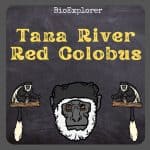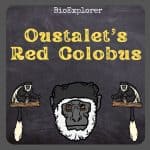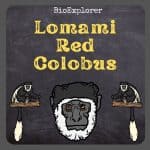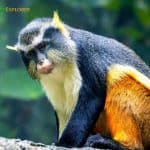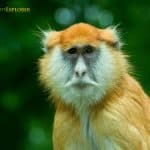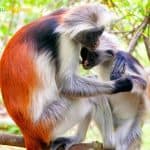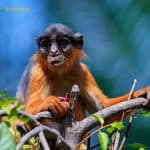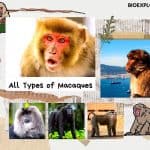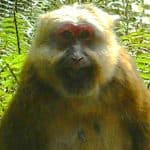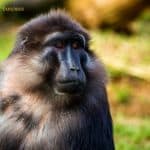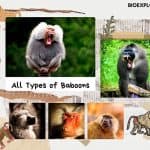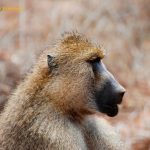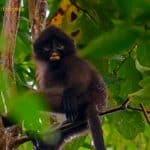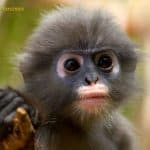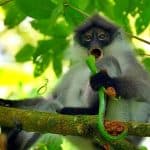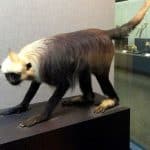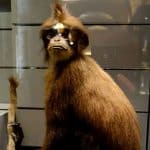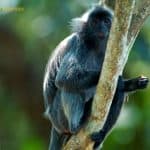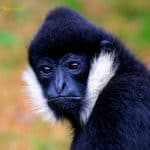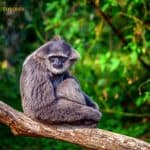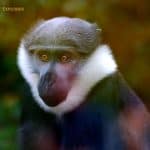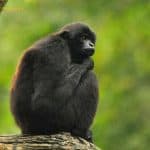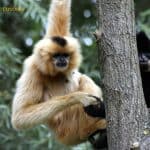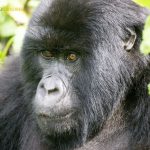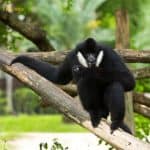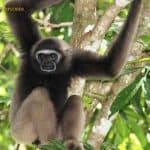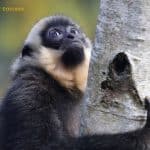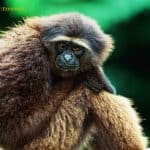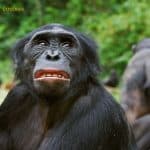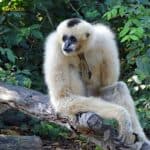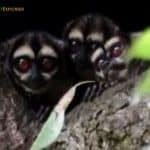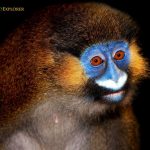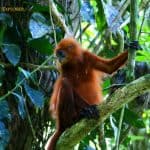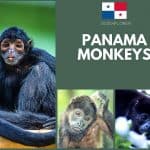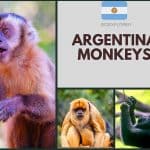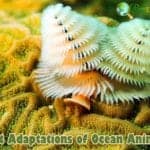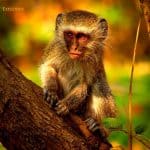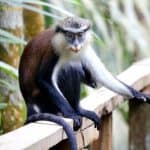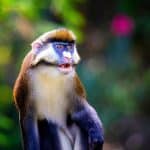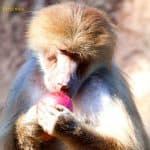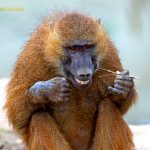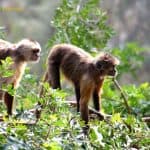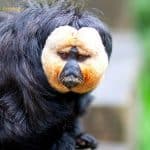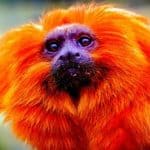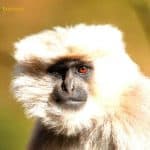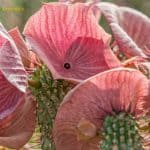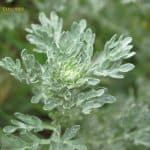types - search results
If you're not happy with the results, please do another search
Tana River Red Colobus
The Tana River red colobus (Piliocolobus rufomitratus), also called the eastern red colobus, is a critically endangered primate species in the Cercopithecidae family. The Tana River red colobus monkeys are the only one of 18 species of red colobus that do not live in the tropical rainforest.
Oustalet’s Red Colobus
(Piliocolobus oustaleti) is another species of red colobus that lives in various forest types in the southern Central African Republic, southern South Sudan, northern Democratic Republic of the Congo, and northeastern Congo.
Miss Waldron’s Red Colobus
Miss Waldron's red colobus (Piliocolobus waldronae) is endemic to West Africa. Miss Waldron's red colobus was discovered in December 1933 by Willoughby P. Lowe, a collector at the British Museum (Natural History).
Lomami Red Colobus
The Lomami red colobus (Piliocolobus parmentieri) is native to central Africa. The Lomani red colobus monkey has a restricted range in the lowland rainforest between the Lomani River and the Lualaba River in the central Democratic Republic of the Congo.
Bouvier’s Red Colobus
Bouvier's Red Colobus was rediscovered in 2015 in the Republic of Congo after four decades without confirmed sightings. These African primates live in the swampy forests surrounding the Congo River, between the mouths of the Oubangui and Alima rivers.
Pig-tailed Langur
The pig-tailed langur (Simias concolor), monotypic in the Simias genus, is a great Old-World monkey native to several small islands off Sumatra, Indonesia. Adult pig-tailed langurs have black faces and small, turned-up noses.
Mentawai Langur
Mentawai Langur is also called the Long-Tailed Langur, and it is native to the Mentawai Islands in Indonesia. The pelage of Mentawai langur is medium length, longer on the back of the shoulders and anterior of the flanks and shorter on the face, neck, abdomen, and under the thighs.
Germain’s Langur
Germain's Langur is a lutung species endemic to Thailand, Vietnam, Laos, Cambodia, and Burma. Germain's langur is a terrestrial tree-dwelling species occasionally found in lowlands.
Black and White Langur
The black-and-white langur is a primate species in the Cercopithecidae family. It was formerly thought to be a subspecies of the Presbytis melalophos (black-crested Sumatran langur). Still, the genetic analysis indicated they were separate species.
Indochinese Black Langur
The Indochinese black langur (Trachypithecus selbstus) is a little-known Lutung endemic to Laos and neighboring Vietnam. Because they live in dense forests and rarely venture outside, observing them in the wild can be difficult.
Wolf’s Mona Monkey
The Wolf's mona monkey (Cercopithecus wolfi), also called the wolf monkey, is a colorful Old-World monkey in the Cercopithecidae family. Wolf's mona monkeys have huge cheek pouches.
Patas Monkey
The Patas Monkey (Erythrocebus patas), also called the Hussar Monkey or Wadi Monkey is a terrestrial monkey distributed in semi-arid areas of West and East Africa. The patas monkey lives in multi-female groups of about 60 individuals (although much larger aggregations have been reported).
Zanzibar Red Colobus
The Zanzibar red colobus (Piliocolobus kirkii) is endemic to Unguja, the main island of the Zanzibar archipelago off the coast of Tanzania. The Zanzibar red colobus, often referred to as Kirk's red colobus is named after Sir John Kirk, the British resident of Zanzibar who first spotted these creatures.
Western Red Colobus
The western red colobus (Piliocolobus badius), also called the Upper Guinean red colobus, rust red colobus, or bay red colobus is a species of Old-World monkey found in the forests of West Africa, from Senegal to Ghana.
Macaques
Macaques are old-world monkeys hailing from the Asian continent, with a few from Africa. Currently, 23 species of living macaques are classified under the genus Macaca in the family Cercopithecinae, and 5 extinct macaques.
White-Cheeked Macaque
The white-cheeked macaque (Macaca leucogenys) is found only in Medog County in southeastern Tibet and the Arunachal Pradesh state of India. The species was first discovered and described by Chinese primatologists Peng-Fei Fan, Cheng Li, and Chao Zhao in the American Journal of Primatology in 2015.
Tonkean Macaque
Tonkean macaques also known as Tonkean black macaques, are endemic to the central part of the island of Sulawesi and the neighboring Togian Islands in Indonesia. Tonkea macaques are pretty intelligent and creative.
Baboons
Baboons are another breed of Old-world monkeys classified under the genus Papio. There are 6 types of baboons. Explore all about baboons here.
Yellow Baboon
The yellow baboon (Papio cynocephalus) is another baboon species in the group of Old World monkeys. They resemble the Chacma baboon but are slightly smaller and have a less elongated snout. Yellow baboons also have white fur on internal surfaces, such as their cheeks and limbs, similar to the color of the human forearm.
What Do Goldfinches Eat? Explore Goldfinch Diets, Hunting & Eating Habits
Goldfinches are mainly omnivores. Explore in detail what do Goldfinches eat by their types, hunting techniques, what eats Goldfinches & more.
Langurs
Langurs are Old-world monkeys classified under the Colobinae family along with other leaf-eating monkeys, including Colobus and proboscis monkeys. Explore langur characteristics and all types of langur species here.
Robinson’s Banded Langur
Robinson's banded langur (Presbytis robinsoni), also known as Robinson's banded surili, is a monkey species in the Cercopithecidae family. Robinson Banded Langurs are generally shy and alert creatures, rarely leaving the comfort of the canopy.
Popa Langur
Popa langur (Trachypithecus popa) is a primate species in the Cercopithecidae family. It occurs exclusively in Myanmar. The species is named after Mount Popa, where a population of 100 monkeys lives.
Pale-Thighed Langur
The pale-thighed surili (Presbytis siamensis), also called the white-thighed langur, is a primate species in the Old World monkey family (Cercopithecidae). Pale-thighed langurs are savvy herbivores; it's fun to say they only eat plants and have a fussy palate, with a preference for young leaves, seeds, and fruits.
White-headed Langur
The white-headed langur (Trachypithecus leucocephalus) is an endangered species of langur native to Guangxi, China. As the common name suggests, a tuft of white fur covers this primate's head.
White-fronted Langur
The white-fronted surili (Presbytis frontata) is a primate species in the Cercopithecidae family, the Old World monkeys. This species prefers to eat immature leaves than more mature leaves.
Silvered Langur
The silvery Lutung (Trachypithecus cristatus), also called the silvery langur or silvered leaf monkey is an Old-World monkey. Silvery Lutungs primarily live in trees.
What Do Orioles Eat? Explore Oriole Diets, Hunting & Eating Habits
Orioles are omnivorous birds grouped in 2 different families. Explore what do orioles eat, orioles diet by types, and what eats orioles here.
Northern White-Cheeked Gibbon
The northern white-cheeked gibbon (Nomascus leucogenys), also called the white-cheeked gibbon, is an endangered species of gibbon endemic to Southeast Asia. Like other members of its genus, both males and females have unusually long arms, even for gibbons, with arms 1.2 to 1.4 times the length of their legs.
Silvery Gibbon
The silvery gibbon (Hylobates moloch), also called the Javan gibbon, is a primate in the gibbon family, Hylobatidae. Silvery gibbons are tree dwellers and feel just as comfortable in the upper canopy as in the undergrowth.
L’hoest Monkey
The L'Hoest monkey (Allocrocebus lhoesti), or mountain monkey, is a vervet monkey found in the upper eastern Congo Basin. L'Hoest monkeys live in relatively small groups, are dominated by females, and have only one male.
Kloss’s Gibbon
Kloss's gibbon (Hylobates klossii), also called the dwarf siamang, Mentawai gibbon, or Bilou, is an endangered primate in the gibbon family Hylobatidae. Kloss's gibbons are territorial, with semi-adult males and adolescents working with their fathers to protect the group's territory.
Hainan Black-Crested Gibbon
The Hainan black-crested gibbon (Nomascus hainanus), also known as Hainan gibbon, is an endangered species of gibbon only found on China's Hainan Island. Hainan black-crested gibbons are found in social groups of females, infants, juveniles, and sometimes males.
Eastern Gorilla
The eastern gorilla is an endangered species of the Gorilla genus and the largest living primate, with an average length of 150 cm for females and 185 cm for males. Eastern gorillas live in stable and cohesive family groups led by a dominant silverback male.
Eastern Black-Crested Gibbon
The eastern black-crested gibbon, also called the Cao-vit crested gibbon or Cao-vit black-crested gibbon, is a gibbon native to northern Vietnam and southeast China. Eastern black-crested gibbons are found in social groups consisting of females, juveniles, infants, and sometimes males.
Eastern Gray Gibbon
The eastern gray gibbon also known as the northern gray gibbon is a primate in the gibbon family, Hylobatidae. Eastern gray gibbons have light brown fur that fades to black on the face, chest, and inner arms, with a white border around the face.
Common Chimpanzee
The chimpanzee, also known simply as the chimp, is a species of great ape native to the forests and savannas of tropical Africa. Chimpanzees and humans are thought to have a common ancestor that lived about eight million years ago.
Southern Yellow-Cheeked Gibbon
The southern yellow-cheeked gibbon, also known as a golden-cheeked gibbon, buffed-cheeked gibbon, red-cheeked gibbon, southern yellow-cheeked crested gibbon, or golden-cheeked crested gibbon, is a species of gibbon endemic to Cambodia, Laos, and Vietnam.
Bornean Gibbon
Also known as the Müller's or gray gibbon, the Bornean gibbon is native to the Bornean Island, which is divided between the nations of Brunei, Malaysia, and Indonesia.
Bonobo
The bonobo (Pan paniscus) is a great ape in danger of extinction. It is one of two species that make up the Pan genus, the other being Pan troglodytes - the common chimpanzee. Bonobos are both arboreal and terrestrial. Most floor movements are characterized by knuckle quadrupedal walking.
Black-Crested Gibbon
Black-crested Gibbons are mainly found in southern China (Yunnan) and some distribution areas in northwestern Laos and northern Vietnam. Black-crested gibbons exhibit sexual dichromatism, with the male being entirely black, while the female is yellowish or tan in color with variable black markings.
Spix’s Night Monkey
The Spix's night monkey (Aotus vociferans), also called the Spix's owl monkey, Colombian gray nocturnal monkey, and noisy night monkey is a species of night monkey native to South America.
Moustached Guenon
The mustached monkey or moustached guenon (Cercopithecus cephus) is a primate species in the Cercopithecidae family. Moustached monkeys take regular paths through the branches, with each monkey following the next along the same path.
Maroon Langur
Endemic to the jungles of Borneo in Indonesia and Malaysia, red leaf monkeys get their name from their shaggy reddish-maroon fur. They are also known as maroon-leaf monkeys and maroon langurs.
Panamian Monkeys
Panama is home to 8 species of New World monkeys, which comprise 6 genera. Examples of these species include the Panamanian night monkey (Aotus zonalis), the brown-headed spider monkey (Ateles fusciceps), and the mantled howler monkey (Alouatta palliata).
Argentinian Monkeys
Five different species spanning 3 genera of New World monkeys can be found in Argentina, though none of them are endemic to the country. These species are generally found in forested regions, mainly in provinces like Santa Fe, Chaco, and Formosa.
Explore 15 Remarkable Adaptations of Ocean Inhabitants
In the realm of flora and fauna, the ocean presents itself as an immense tapestry of diverse habitats. Embark on a journey through the 15 most extraordinary adaptations of ocean creatures.
Angolan Monkeys
Angola is home to 13 species of Old World monkeys that make up 6 genera; however, none of these species are endemic to the country. One of the most popular species is the red-tailed monkey. Explore all Angola monkeys here.
Old World Monkeys Vs. New World Monkeys
Old-world and New-world monkeys are two types of monkeys within Primates. Explore all differences between them from all aspects here.
Malbrouck
The Malbrouck (Chlorocebus cynosuros) is an Old-World primate from Africa that belongs to the Chlorocebus genus. The species is sometimes classified as a subspecies of the green monkey (Chlorocebus pygerythrus) or the common grivet (Chlorocebus aethiops).
Lowe’s Mona Monkey
Lowe's Mona monkey (Cercopithecus lowei) is an Old-World monkey in the Cercopithecidae family found from Ghana to the Ivory Coast. Lowe's Mona monkeys generally consist of one male and several females.
Lesser Spotted-Nosed Monkey
The lesser spotted-nosed monkey, lesser spotted monkey, or lesser white-nosed monkey (Cercopithecus petaurista) is a primate species in the Cercopithecidae family. The lesser spotted-nosed monkey is diurnal, arboreal, and cryptic.
Hamadryas Baboon
The Hamadryas baboon (Papio hamadryas) is a baboon species in the Old World monkey family. The Hamadryas baboon was a sacred animal to the ancient Egyptians. It appeared in various roles in ancient Egyptian religion, hence its alternative common name, "sacred baboon".
Guinea Baboon
The Guinea baboon (Papio papio) is a baboon of the Old World monkey family. When walking, these baboons support their weight on the bottom of their toes in front and on the entire sole of their feet.
Guianan Weeper Capuchin
The wedge-capped capuchin (Cebus olivaceus), also known as Guianan weeper capuchin, is a capuchin monkey native to South America. Wedge-capped capuchins get their name from a black triangle of dark fur centered on their forehead.
Guianan Saki
The white-faced saki (Pithecia pithecia), also known as the golden-faced saki, Guianan saki, and Guyana saki, is a New World saki monkey species. Typically, they have a lifespan of around 14 years in the wild and have lived up to 36 years in captivity.
Orange Monkeys
Some monkey species are born with bright orange fur; the coat color would gradually turns black as they age, but some stay orange throughout life. Explore all types of orange-colored monkeys here.
Gray Monkeys
Gray-colored monkeys are one of the commonly found monkeys in primates. Explore all types of gray monkeys here.
Hoodia Cactus
The Hoodia cactus is a flowering plant of the family Apocynaceae. It has been called one of the 21st century’s wonder plants. Hoodia gordonii shares many similarities with the cactus but does not belong to the cactus family. Instead, the Hoodia cactus belongs to the milkweed family.
White Wormwood
White Wormwood is a perennial shrub of the order Asterales. This shrub can grow to a height of 8-16 inches. The White Wormwoods are chamaephyte. The plant is also aromatic. In addition, white Wormwood produces essential oils.


